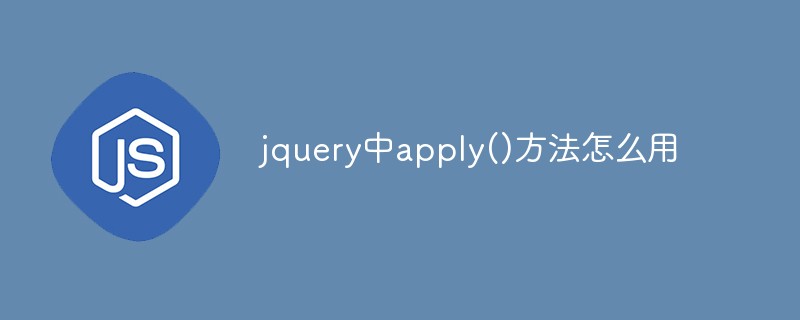 Web Front-end
Web Front-end JS Tutorial
JS Tutorial Detailed explanation of the usage of $.get, $.post, $.getJSON and $.ajax in jQuery
Detailed explanation of the usage of $.get, $.post, $.getJSON and $.ajax in jQueryThe focus of this chapter is to talk about the four methods of calling ajax in jQuery: $.get, $.post, $getJSON, $ajax.
When we are "happy" to write ajax programs in javascript, suddenly someone tells you that there is a thing called jquery, which will tell you how happy it is not to directly interact with HttpRequest, and at the same time, you will no longer You no longer need to worry about the garbled ajax code problem. What's even better is that your js code will be greatly simplified. After reading this article, you will find that ajax is simply a matter of one sentence.
1. $.get
The $.get() method uses the GET method to make asynchronous requests. Its syntax structure is:
$.get( url [, data] [, callback] );
Explain the various parameters of this function:
url: string type, the address of the ajax request.
data: Optional parameter, object type. The key/value data sent to the server will be appended to the request URL as QueryString.
callback: optional parameter, function type, this function is automatically called when ajax returns successfully.
Finally write an example of $.get() for your reference:
$.get(
"submit.aspx",{
id: '123',
name: '青藤园',
},function(data,state){
//这里显示从服务器返回的数据
alert(data);
//这里显示返回的状态
alert(state);
}
)2. $.post()
$.post() method uses POST method to make asynchronous requests. Its syntax structure is:
$.post(url,[data],[callback],[type]);
This method is similar to $.get(), except that there is an additional type parameter, then Here we only introduce the type parameter. For other information, please refer to $.get() above.
type: type is the requested data type, which can be html, xml, json, etc. If we set this parameter to: json, then the returned format will be in json format. If not set, it will be the same as The format returned by $.get() is the same, both are strings.
Finally write an example of $.post() for your reference:
$.post(
"submit.aspx",{
id: '123',
name: '青藤园',
},function(data,state){
//这里显示从服务器返回的数据
alert(data);
//这里显示返回的状态
alert(state);
},
"json"
)3. $.getJSON()
$. getJSON() is specially set up for ajax to obtain json data, and supports cross-domain calls. Its syntax format is:
getJSON(url,[data],[callback]);
url: string type, sending request address data: optional parameter, to be Send Key/value parameters, same as get and post type data callback: Optional parameter, callback function when loading is successful, same as get and post type callback
JSON is an ideal data transmission format. It can be well integrated with JavaScript or other host languages, and can be used directly by JS. Using JSON is more structurally reasonable and safer than sending "nude" data directly through GET and POST. As for jQuery's getJSON() function, it is just a simplified version of the ajax() function with JSON parameters set. This function can also be used across domains and has certain advantages over get() and post(). In addition, this function can let the program execute the callback function X by writing the request url in the format of "myurl?callback=X".
4. $.ajax()
$.ajax() is a common ajax package in jquery. Its syntax format is:
$.ajax(options);
The options is an object type, which specifies the specific parameters of this ajax call. Here I attach the most commonly used parameters
$.ajax({
url: 'submit.aspx',
datatype: "json",
type: 'post',
success: function (e) { //成功后回调
alert(e);
},
error: function(e){ //失败后回调
alert(e);
},
beforeSend: function(){ /发送请求前调用,可以放一些"正在加载"之类额话
alert("正在加载");
}
})The above is how jquery implements ajax calls. Method, ajax calling is quite complicated. I hope this chapter can be helpful to everyone. For more related tutorials, please visit jQuery Video Tutorial, AJAX Video Tutorial!
 jquery实现多少秒后隐藏图片Apr 20, 2022 pm 05:33 PM
jquery实现多少秒后隐藏图片Apr 20, 2022 pm 05:33 PM实现方法:1、用“$("img").delay(毫秒数).fadeOut()”语句,delay()设置延迟秒数;2、用“setTimeout(function(){ $("img").hide(); },毫秒值);”语句,通过定时器来延迟。
 jquery怎么修改min-height样式Apr 20, 2022 pm 12:19 PM
jquery怎么修改min-height样式Apr 20, 2022 pm 12:19 PM修改方法:1、用css()设置新样式,语法“$(元素).css("min-height","新值")”;2、用attr(),通过设置style属性来添加新样式,语法“$(元素).attr("style","min-height:新值")”。
 axios与jquery的区别是什么Apr 20, 2022 pm 06:18 PM
axios与jquery的区别是什么Apr 20, 2022 pm 06:18 PM区别:1、axios是一个异步请求框架,用于封装底层的XMLHttpRequest,而jquery是一个JavaScript库,只是顺便封装了dom操作;2、axios是基于承诺对象的,可以用承诺对象中的方法,而jquery不基于承诺对象。
 jquery怎么在body中增加元素Apr 22, 2022 am 11:13 AM
jquery怎么在body中增加元素Apr 22, 2022 am 11:13 AM增加元素的方法:1、用append(),语法“$("body").append(新元素)”,可向body内部的末尾处增加元素;2、用prepend(),语法“$("body").prepend(新元素)”,可向body内部的开始处增加元素。
 jquery中apply()方法怎么用Apr 24, 2022 pm 05:35 PM
jquery中apply()方法怎么用Apr 24, 2022 pm 05:35 PM在jquery中,apply()方法用于改变this指向,使用另一个对象替换当前对象,是应用某一对象的一个方法,语法为“apply(thisobj,[argarray])”;参数argarray表示的是以数组的形式进行传递。
 jquery怎么删除div内所有子元素Apr 21, 2022 pm 07:08 PM
jquery怎么删除div内所有子元素Apr 21, 2022 pm 07:08 PM删除方法:1、用empty(),语法“$("div").empty();”,可删除所有子节点和内容;2、用children()和remove(),语法“$("div").children().remove();”,只删除子元素,不删除内容。
 jquery on()有几个参数Apr 21, 2022 am 11:29 AM
jquery on()有几个参数Apr 21, 2022 am 11:29 AMon()方法有4个参数:1、第一个参数不可省略,规定要从被选元素添加的一个或多个事件或命名空间;2、第二个参数可省略,规定元素的事件处理程序;3、第三个参数可省略,规定传递到函数的额外数据;4、第四个参数可省略,规定当事件发生时运行的函数。
 jquery怎么去掉只读属性Apr 20, 2022 pm 07:55 PM
jquery怎么去掉只读属性Apr 20, 2022 pm 07:55 PM去掉方法:1、用“$(selector).removeAttr("readonly")”语句删除readonly属性;2、用“$(selector).attr("readonly",false)”将readonly属性的值设置为false。


Hot AI Tools

Undresser.AI Undress
AI-powered app for creating realistic nude photos

AI Clothes Remover
Online AI tool for removing clothes from photos.

Undress AI Tool
Undress images for free

Clothoff.io
AI clothes remover

AI Hentai Generator
Generate AI Hentai for free.

Hot Article

Hot Tools

ZendStudio 13.5.1 Mac
Powerful PHP integrated development environment

Safe Exam Browser
Safe Exam Browser is a secure browser environment for taking online exams securely. This software turns any computer into a secure workstation. It controls access to any utility and prevents students from using unauthorized resources.

DVWA
Damn Vulnerable Web App (DVWA) is a PHP/MySQL web application that is very vulnerable. Its main goals are to be an aid for security professionals to test their skills and tools in a legal environment, to help web developers better understand the process of securing web applications, and to help teachers/students teach/learn in a classroom environment Web application security. The goal of DVWA is to practice some of the most common web vulnerabilities through a simple and straightforward interface, with varying degrees of difficulty. Please note that this software

SublimeText3 English version
Recommended: Win version, supports code prompts!

VSCode Windows 64-bit Download
A free and powerful IDE editor launched by Microsoft





